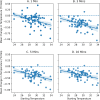Detecting accelerometer non-wear periods using change in acceleration combined with rate-of-change in temperature
- PMID: 35596151
- PMCID: PMC9123693
- DOI: 10.1186/s12874-022-01633-6
Detecting accelerometer non-wear periods using change in acceleration combined with rate-of-change in temperature
Abstract
Background: Accelerometery is commonly used to estimate physical activity, sleep, and sedentary behavior. In free-living conditions, periods of device removal (non-wear) can lead to misclassification of behavior with consequences for research outcomes and clinical decision making. Common methods for non-wear detection are limited by data transformations (e.g., activity counts) or algorithm parameters such as minimum durations or absolute temperature thresholds that risk over- or under-estimating non-wear time. This study aimed to advance non-wear detection methods by integrating a 'rate-of-change' criterion for temperature into a combined temperature-acceleration algorithm.
Methods: Data were from 39 participants with neurodegenerative disease (36% female; age: 45-83 years) who wore a tri-axial accelerometer (GENEActiv) on their wrist 24-h per day for 7-days as part of a multi-sensor protocol. The reference dataset was derived from visual inspection conducted by two expert analysts. Linear regression was used to establish temperature rate-of-change as a criterion for non-wear detection. A classification and regression tree (CART) decision tree classifier determined optimal parameters separately for non-wear start and end detection. Classifiers were trained using data from 15 participants (38.5%). Outputs from the CART analysis were supplemented based on edge cases and published parameters.
Results: The dataset included 186 non-wear periods (85.5% < 60 min). Temperature rate-of-change over the first five minutes of non-wear was - 0.40 ± 0.17 °C/minute and 0.36 ± 0.21 °C/minute for the first five minutes following device donning. Performance of the DETACH (DEvice Temperature and Accelerometer CHange) algorithm was improved compared to existing algorithms with recall of 0.942 (95% CI 0.883 to 1.0), precision of 0.942 (95% CI 0.844 to 1.0), F1-Score of 0.942 (95% CI 0.880 to 1.0) and accuracy of 0.996 (0.994-1.000).
Conclusion: The DETACH algorithm accurately detected non-wear intervals as short as five minutes; improving non-wear classification relative to current interval-based methods. Using temperature rate-of-change combined with acceleration results in a robust algorithm appropriate for use across different temperature ranges and settings. The ability to detect short non-wear periods is particularly relevant to free-living scenarios where brief but frequent removals occur, and for clinical application where misclassification of behavior may have important implications for healthcare decision-making.
Keywords: Accelerometry; Algorithm; Behavior classification; Non-wear detection; Physical activity; Remote monitoring; Wearables.
© 2022. The Author(s).
Conflict of interest statement
The authors declare that they have no competing interests.
Figures




Similar articles
-
Classification of accelerometer wear and non-wear events in seconds for monitoring free-living physical activity.BMJ Open. 2015 May 11;5(5):e007447. doi: 10.1136/bmjopen-2014-007447. BMJ Open. 2015. PMID: 25968000 Free PMC article.
-
Non-wear or sleep? Evaluation of five non-wear detection algorithms for raw accelerometer data.J Sports Sci. 2020 Feb;38(4):399-404. doi: 10.1080/02640414.2019.1703301. Epub 2019 Dec 11. J Sports Sci. 2020. PMID: 31826746
-
Feasibility of Using a GENEActiv Accelerometer with Triaxial Acceleration and Temperature Sensors to Monitor Adherence to Shoulder Sling Wear Following Surgery.Sensors (Basel). 2024 Jan 29;24(3):880. doi: 10.3390/s24030880. Sensors (Basel). 2024. PMID: 38339597 Free PMC article.
-
Validity of objective methods for measuring sedentary behaviour in older adults: a systematic review.Int J Behav Nutr Phys Act. 2018 Nov 26;15(1):119. doi: 10.1186/s12966-018-0749-2. Int J Behav Nutr Phys Act. 2018. PMID: 30477509 Free PMC article.
-
Quantifying the Effect of Monitor Wear Time and Monitor Type on the Estimate of Sedentary Time in People with COPD: Systematic Review and Meta-Analysis.J Clin Med. 2022 Apr 1;11(7):1980. doi: 10.3390/jcm11071980. J Clin Med. 2022. PMID: 35407588 Free PMC article. Review.
Cited by
-
SciKit digital health package for accelerometry-measured physical activity: comparisons to existing solutions and investigations of age effects in healthy adults.Front Digit Health. 2023 Nov 27;5:1321086. doi: 10.3389/fdgth.2023.1321086. eCollection 2023. Front Digit Health. 2023. PMID: 38090655 Free PMC article.
-
Wrist Accelerometer Estimates of Physical Activity Intensity During Walking in Older Adults and People Living With Complex Health Conditions: Retrospective Observational Data Analysis Study.JMIR Form Res. 2023 Mar 15;7:e41685. doi: 10.2196/41685. JMIR Form Res. 2023. PMID: 36920452 Free PMC article.
-
A proof of concept for wear/non-wear classification using accelerometer data in daily activity recording: Synthetic algorithm leveraging probability and continuity of zero counts.PLoS One. 2024 Oct 22;19(10):e0309917. doi: 10.1371/journal.pone.0309917. eCollection 2024. PLoS One. 2024. PMID: 39436886 Free PMC article.
-
Measuring resting heart rate during daily life using wearable technology: Examining the impact of behavioral context and methodological criteria.Digit Health. 2025 Aug 14;11:20552076251367506. doi: 10.1177/20552076251367506. eCollection 2025 Jan-Dec. Digit Health. 2025. PMID: 40823628 Free PMC article.
-
Generalizability and performance of methods to detect non-wear with free-living accelerometer recordings.Sci Rep. 2023 Feb 13;13(1):2496. doi: 10.1038/s41598-023-29666-x. Sci Rep. 2023. PMID: 36782015 Free PMC article.
References
-
- Morgan C, Rolinski M, McNaney R, Jones B, Rochester L, Maetzler W, et al. Systematic review looking at the use of technology to measure free-living symptom and activity outcomes in Parkinson’s disease in the home or a home-like environment. J Parkinsons Dis. 2020;10:429–454. doi: 10.3233/JPD-191781. - DOI - PMC - PubMed
Publication types
MeSH terms
LinkOut - more resources
Full Text Sources
Medical

